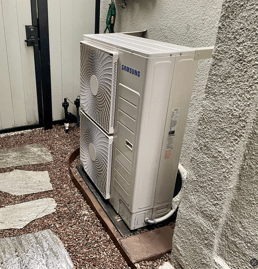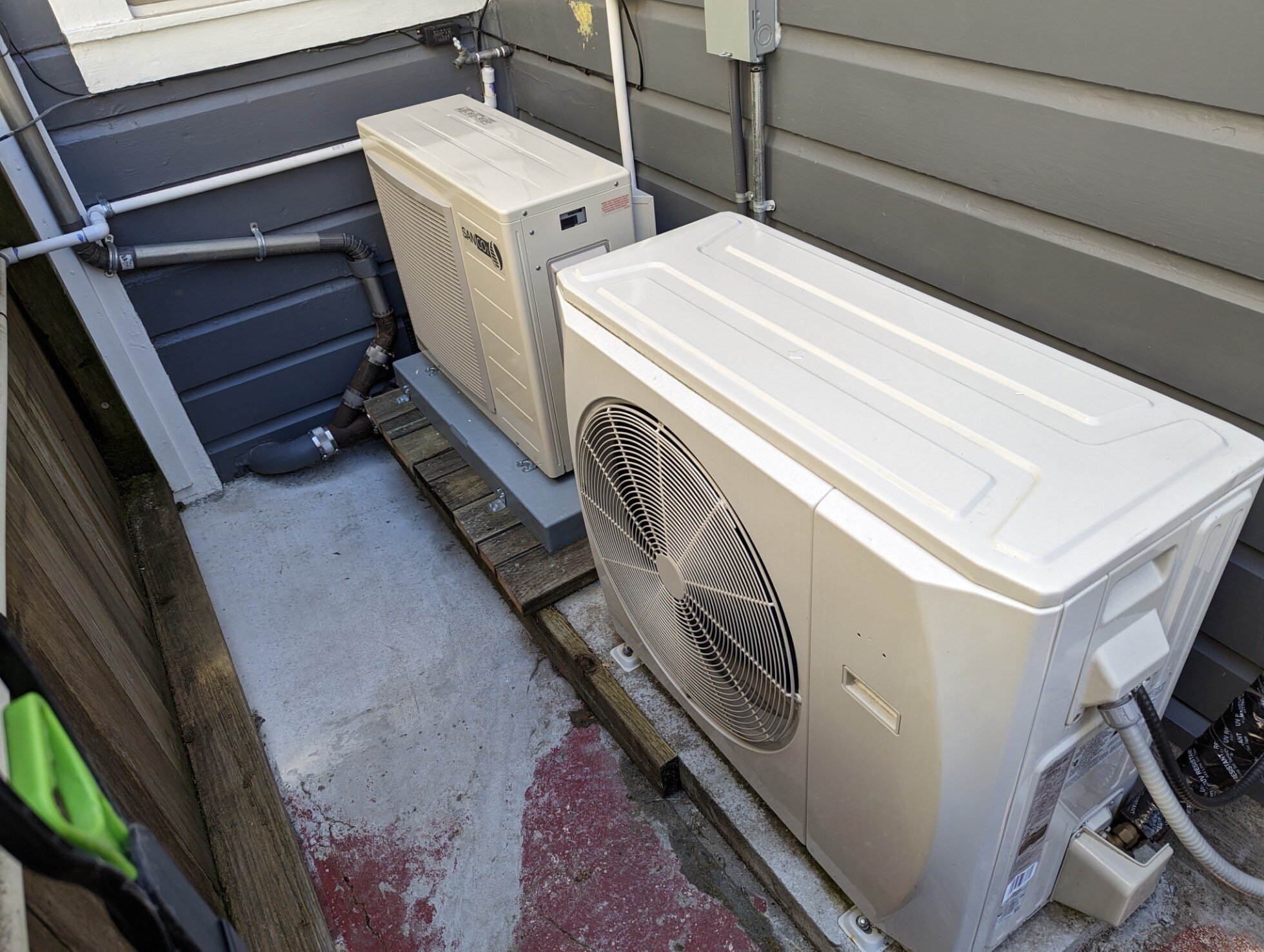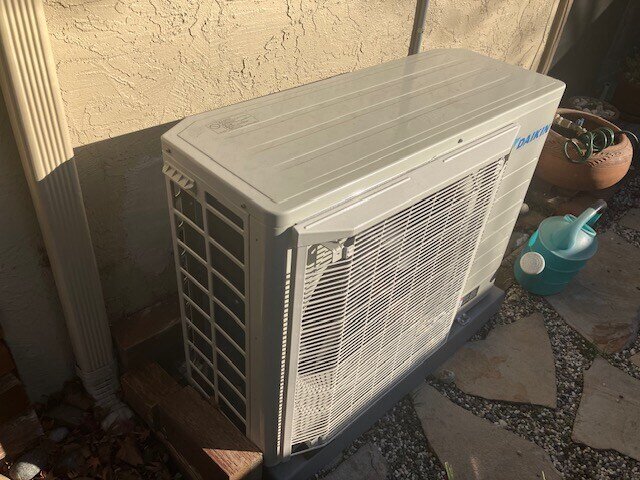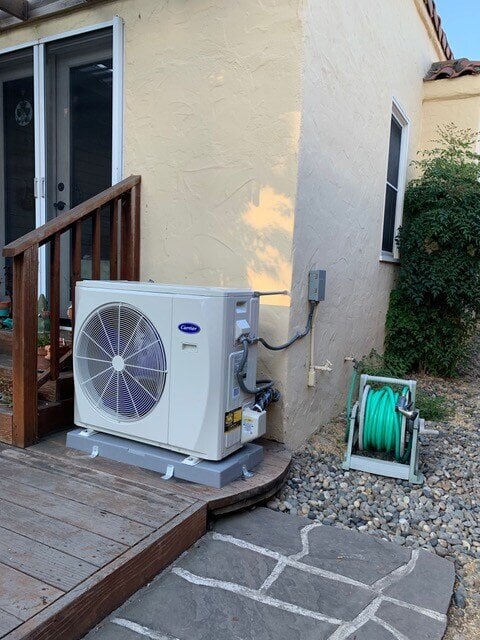Heat Pumps in California: Everything You Need to Know
Article published September 2024.
If you're a California homeowner interested in making your home safer and more comfortable, a heat pump might just be your best bet! These innovative systems operate at their best in mild climates such as California, delivering both heating and cooling in a single highly efficient machine.
Energy efficiency can lead to big energy savings – plus, with generous state and local rebates and incentives, installing a heat pump now is a smart investment. Clean-energy upgrades not only boost your home’s value but also remove the harmful, dangerous pollutants generated by gas-powered systems. It’s a win for your home, your health AND the environment!
Let's dive into why heat pumps are a fantastic choice for California homes. For additional reading, see our Complete Guide to Heat Pumps.
Why should you trust us?
Here at QuitCarbon, our expert planners have helped thousands of homeowners evaluate the best heat pump water heater options for their homes.
We provide free ENERGY STAR® certified guidance along with vetted local contractors to upgrade your home with heat pumps, induction cooking, EV chargers, solar, batteries, and more.
QuitCarbon has won prizes from the US Department of Energy and we collaborate with the Pacific Northwest National Laboratories and the National Renewable Energy Laboratory (NREL) to improve the accuracy of our content.
Article Contents
- What Is a Heat Pump?
- How Well Do Heat Pumps Work in California?
- How to Choose the Right Heat Pump
- Types of Heat Pump Systems
- All-Electric vs Duel Fuel Heat Pumps
- How Much Do Heat Pumps Cost in California?
- Understanding Heat Pump Rebates in California
- Heat Pumps vs Furnaces and ACs
- New Heat Pump Technology Developments in 2024
What Is a Heat Pump?
A heat pump is a basically a single machine that does the job of a furnace and a central AC. In the summer it keeps your house cool, and in the winter it can reverse and move heat into your home. Since they run on electricity, heat pumps don’t rely on flammable fuels like natural gas or propane – nor do they pose the risk of carbon monoxide leaks, fires, or explosions.
Key features of heat pumps include:
- Dual functionality for both heating and cooling
- Higher energy efficiency compared to conventional systems
- Advanced features like variable-speed fans for enhanced temperature control
How Well Do Heat Pumps Work in California?
Heat pumps are exceptionally well-suited to California's mild climate. Their effectiveness varies across different regions:
- Coastal areas: Heat pumps operate at peak efficiency in mild temperatures.
- Northern regions: Modern heat pumps perform admirably even in cooler areas.
- Inland areas: Heat pumps provide efficient cooling and heating in hotter climates.
According to the U.S. Department of Energy, heat pumps can reduce electricity use for heating by approximately 65% compared to electric resistance heating, such as furnaces or baseboard heaters. Heat pumps are particularly effective in California due to the mild climate in many regions, allowing for efficient operation year-round.
"We ultimately decided the most important first step was to replace our old furnace with a heat pump, and are now the proud owners of a new Fujitsu systems that's cut our gas usage by more than 50%. QuitCarbon folks were great advisors throughout and did it all for free - couldn't ask for more." - Peter L., San Francisco
How to Choose the Right Heat Pump
Assessing Home Needs
When choosing a heat pump in California, it’s important to understand the unique heating and cooling needs of your home. Factors such as square footage, insulation quality, and climate conditions play a substantial role. A free home assessment from QuitCarbon will take into consideration your existing HVAC infrastructure and lifestyle factors, and provide insight into what type of heat pump would yield the greatest efficiency for you.
Determining the Right Size for Your Home
The size of a heat pump is typically measured in tons or British Thermal Units (BTUs) per hour. QuitCarbon and one of our vetted contractors can assess what's best for your home, factoring in the following:
- Square footage of your home: The larger your home, the more heating and cooling capacity you will need. For example, a 2,000-square-foot home typically requires a heat pump with a capacity of 2.5 to 3.5 tons (30,000–42,000 BTUs).
- Climate zone: Warmer areas like southern California might need a lower BTU output compared to colder areas like northern California or high-altitude regions.
- Insulation: Homes with better insulation and energy-efficient windows may require a smaller heat pump than older homes with poor insulation.
- Home orientation: Homes with more sunlight exposure may require different capacities, depending on how much solar heat gain occurs.
Considering Efficiency Ratings
When comparing heat pumps, focus on efficiency ratings like Seasonal Energy Efficiency Ratio (SEER) and Heating Seasonal Performance Factor (HSPF):
- SEER: Measures cooling efficiency; the higher the SEER, the more efficient the unit. A SEER rating of 14 or higher is recommended in California’s warmer regions.
- HSPF: Measures heating efficiency; an HSPF rating of 8 or higher is considered efficient. Cold climate heat pumps often have higher HSPF ratings to maximize heating in colder weather.
Look for the Energy Star label as an indicator of a high-efficiency heat pump. Another useful metric is the Coefficient of Performance (COP) rating, which shows the heat pump's efficiency in transferring heat versus electrical energy consumed. For those living in areas with harsh winters, cold climate heat pump models are specifically designed for optimal heating performance even at very low temperatures.
Types of Heat Pump Systems
Air-source heat pumps are the most common type of system. They provide a safer, cleaner alternative for home heating and cooling than traditional systems that run on gas or propane.
When installed correctly, an air-source heat pump can provide up to three times more heat energy to a home than the electricity it uses. This is because heat pumps transfer heat instead of generating it by burning fuel.

Image source: Energy.gov
Air-source heat pumps come in two varieties:
- Ductless mini-split heat pumps are ideal for homes without ductwork. They're more efficient than ducted systems, since there's no energy loss through ductwork.
Ductless mini-splits have an outdoor compressor unit connected to one or more indoor air-handling units – meaning you can heat and cool specific areas or rooms. (How great is that?) The indoor units are visible on walls or ceilings...but we think they're quite attractive!

- Ducted heat pumps are better suited for whole-home heating and cooling in houses that already have ductwork installed. They typically have a single indoor air-handling unit, often located in an attic or basement.
Californians who live the state's coldest areas, such as the high sierra, may want to consider a cold climate heat pump. These systems are specifically designed to work in sub-zero temperatures. Hyper-efficient and quiet, they also efficiently cool your home during summer months. Carbon Switch provides recommendations for the best cold climate heat pumps.
Other options include ground-source (geothermal) heat pumps. These are more expensive to install but offer the highest efficiency by using stable underground temperatures to transfer heat. They work just fine in in both extreme and mild climates.
All-Electric vs Dual Fuel Heat Pumps
Electric-only heat pumps are especially attractive in California because they’re more energy-efficient and better for the environment—plus, they align with the state's ambitious carbon reduction goals. While all-electric systems can cost more upfront, they typically pay off with lower operating costs and generous incentives that favor all-electric systems.
Dual fuel systems, which can switch between natural gas and electricity, offer some flexibility and a bit more heating power during those rare cold snaps. This can be useful for older or less-insulated homes. But with California planning to phase out new gas furnaces by 2030, going electric is definitely the future. For most homes, especially newer or well-insulated ones, all-electric heat pumps are the smarter choice for saving money, cutting carbon, and staying ahead of the curve.
How Much Do Heat Pumps Cost in California?
The cost of heat pumps in California can vary widely depending on factors such as the size of your home, the type of system, and installation complexity. According to data from TECH Clean California, the average cost of a heat pump installation in California was $17,287 between December 2021 and May 2022. Find real-time data for your specific region with their handy interactive map.
In a nutshell, ductless mini-splits are typically more affordable to install because they don't need ducts and are easier to retrofit into existing homes. Purchase and installation costs in California start at $7,000 and up. Ducted heat pumps usually start at $15,000 and up.
While the upfront costs may seem high, the long-term energy savings and available rebates can significantly offset these initial expenses. Also consider that a heat pump does the job of both an air conditioner and furnace – and does it much better! – at a comparable cost.
Understanding Heat Pump Rebates in California
California offers generous rebates and incentives for homeowners who install energy-efficient heat pumps.
Rebates for Heat Pumps in California
$1,000 for heat pump
$2,000 for heat pump
- Under the Inflation Reduction Act of 2022, homeowners can qualify for federal tax credits of up to 30% of the total system cost, capped at $2,000.
- Federal tax rebates are coming in 2025 for qualifying households.
-
The TECH Clean California program offers a $1,000 rebate for new heat pumps and heat pump water heaters (HPWHs).
- Local utilities and CCAs (Community Choice Aggregators) often offer rebates and incentives; check with yours, or ask QuitCarbon.
Also keep in mind that installing an all-electric heat pump is a big step toward full home electrification – and generous rebates from the California Energy-Smart Homes Program. In 2024, homeowners can receive up to $5,500 for qualifying upgrades.
If you think this sounds complicated...you're not alone. That's why our clients love the help we provide navigating and maximizing the available rebates!
"Y'all were so helpful in making our transition to getting our home off fossil fuels. Very easy in terms of excellent advice including navigating confusing paperwork for securing rebates." – Robert , QuitCarbon client
Heat Pumps vs Furnaces and ACs
When comparing heat pumps to furnaces ACs in California, several factors come into play, as shown in the table below.
Energy efficiency stands out as a leading benefit: while the most efficient gas furnaces have an Annual Fuel Utilization Efficiency (AFUE) of up to 98%, heat pumps can achieve effective efficiencies of 300% or more. And the Seasonal Energy Efficiency Ratio (SEER) for modern heat pumps can reach up to 30, while most central ACs max out at around 21 SEER.
| Feature | Heat Pump | Air Conditioner | Furnace |
|---|---|---|---|
| Functionality | Heating and cooling | Cooling only | Heating only |
| Energy Efficiency | Very high (SEER up to 20, AFUE up to 300%) | Moderate (SEER up to 21) | Moderate (AFUE up to 98%) |
| Environmental Impact | Low (no onsite emissions) | Moderate | Higher (burns fossil fuels) |
| Performance in Mild Climates | Excellent | Good (for cooling) | Good (for heating) |
| Performance in Extreme Heat | Excellent | Good | N/A |
| Performance in Extreme Cold | Good (with recent improvements) | N/A | Excellent |
| Versatility | High (year-round use) | Limited to cooling | Limited to heating |
| Initial Cost | Higher | Moderate | Moderate |
| Rebates and Incentives in CA | Numerous | Some | Few |
| Best Suited for | Most California homes | Very hot areas with minimal heating needs | Cold areas or as part of a hybrid system |
New Heat Pump Technology Developments in 2024
The heat pump world is buzzing with innovation, bringing several exciting upgrades to the market. Here’s a look at what’s new:
-
Harvest system: Harvest combines both home heat and hot water using a single efficient heat pump. For more info, see our Help article "What is Harvest, and is it right for my home?"

- Even higher efficiency: Heat pump technology keeps pushing the envelope on energy efficiency. Some models are now hitting SEER ratings of 30 or more, thanks in large part to advancements in variable-speed (inverter) compressors. These compressors adjust power use based on demand, resulting in significant energy savings.
-
Smart thermostats: Many of the latest heat pump models come equipped with advanced smart home features. Homeowners can now fine-tune their systems with more precision and optimize energy use, all from a mobile app. Plus, the integration of heat pumps with renewable energy sources like solar panels is becoming more common. These options make it easier than ever to optimize your home's energy efficiency!
- Improved cold-weather performance: Leading brands like Mitsubishi and Daikin have launched heat pumps that can maintain top efficiency even in sub-zero temperatures. This is a game-changer for California's coldest regions; heat pumps are now a viable option for year-round comfort.
-
Refrigerant Innovations: More manufacturers are switching to environmentally friendly refrigerants like R-32, which have a lower global warming potential. This shift helps reduce the environmental impact of heat pumps, making them an even greener choice.
-
Heat Exchanger design: New designs, such as micro-channel heat exchangers, are improving the efficiency of heat transfer while reducing system size. This makes heat pumps even more practical for homes in urban or space-constrained areas.
These advancements make heat pumps more efficient, versatile, and eco-friendly than ever before—perfect for anyone looking to upgrade their home’s HVAC system.
Conclusion
With generous rebates and continuing technological advancements, California is pushing homeowners toward zero-emissions alternatives like heat pumps and heat pump water heaters. And with a proposed state-wide ban on new gas furnaces and water heaters slated to begin in 2030, now is a great time to future-proof your home by investing in a heat pump system.
Consult with QuitCarbon to determine the best system for your specific needs and to ensure you take full advantage of available rebates. By making an informed decision with trusted experts, you'll enjoy a more comfortable home, reduce your energy bills, and contribute to California's sustainability goals.




